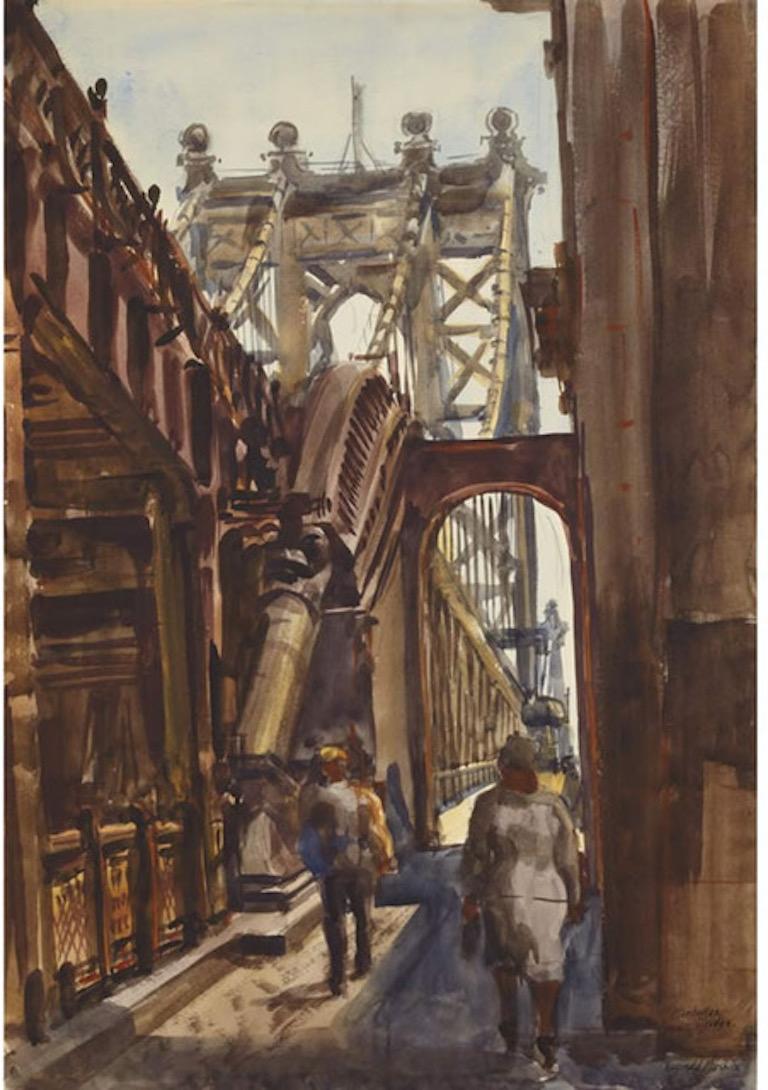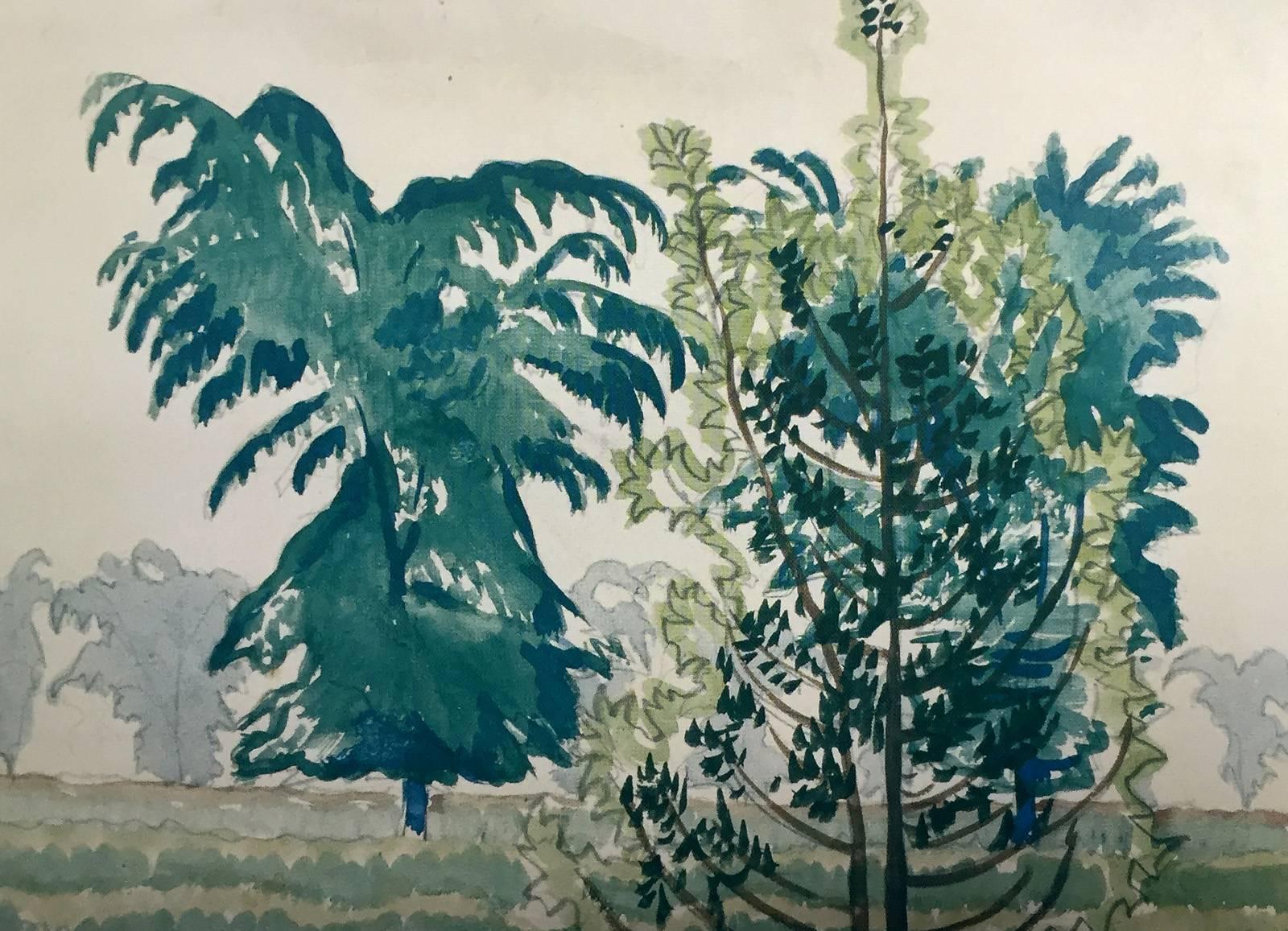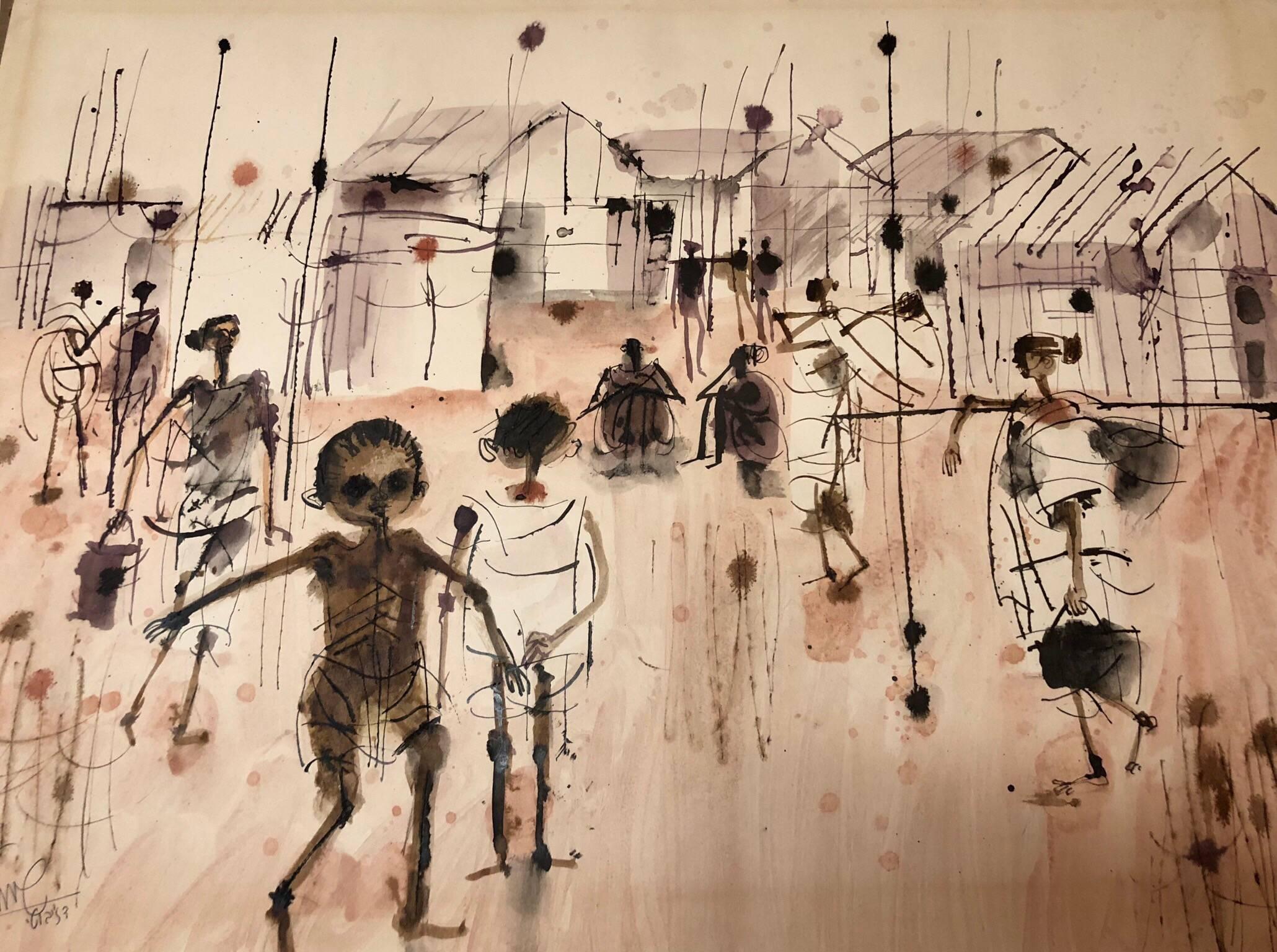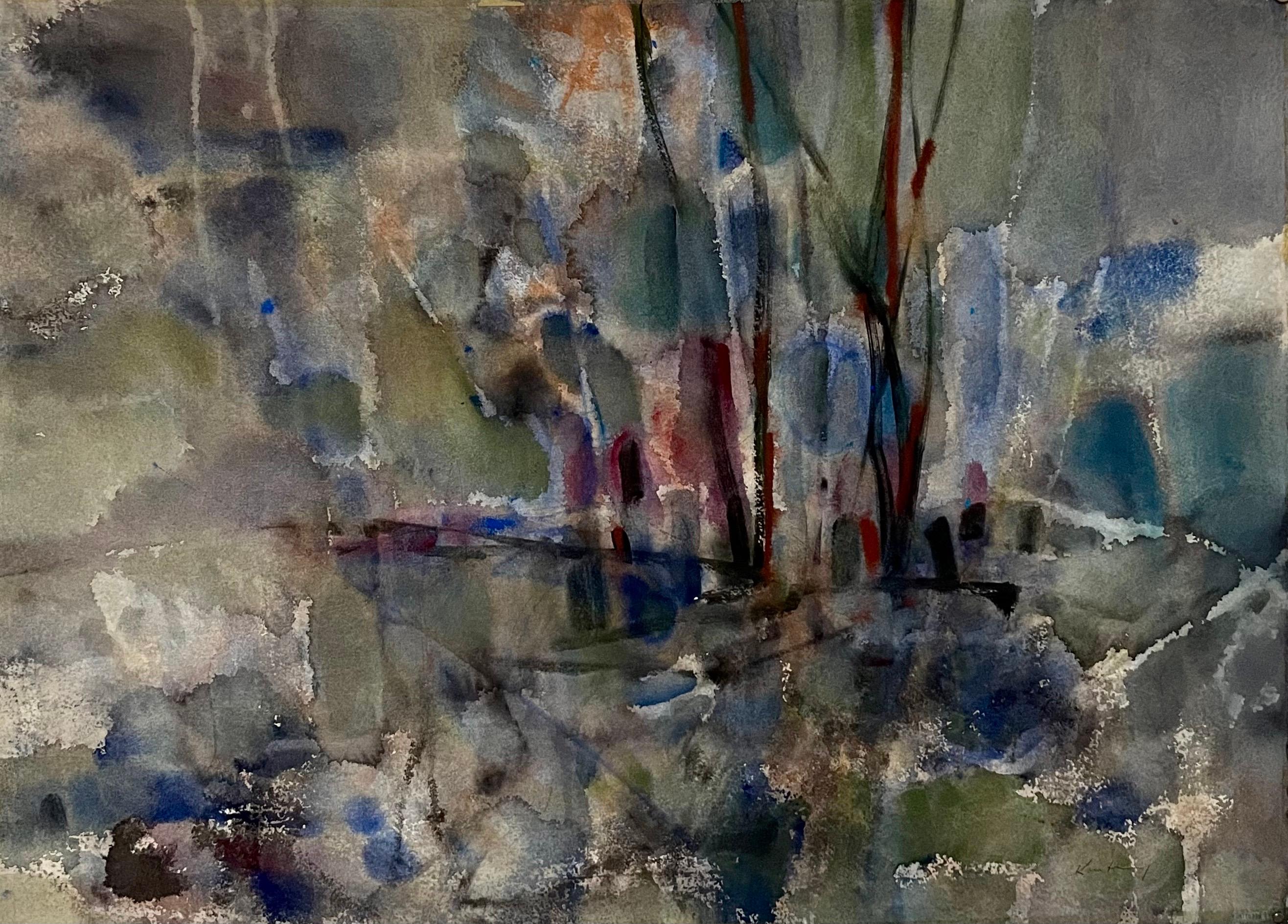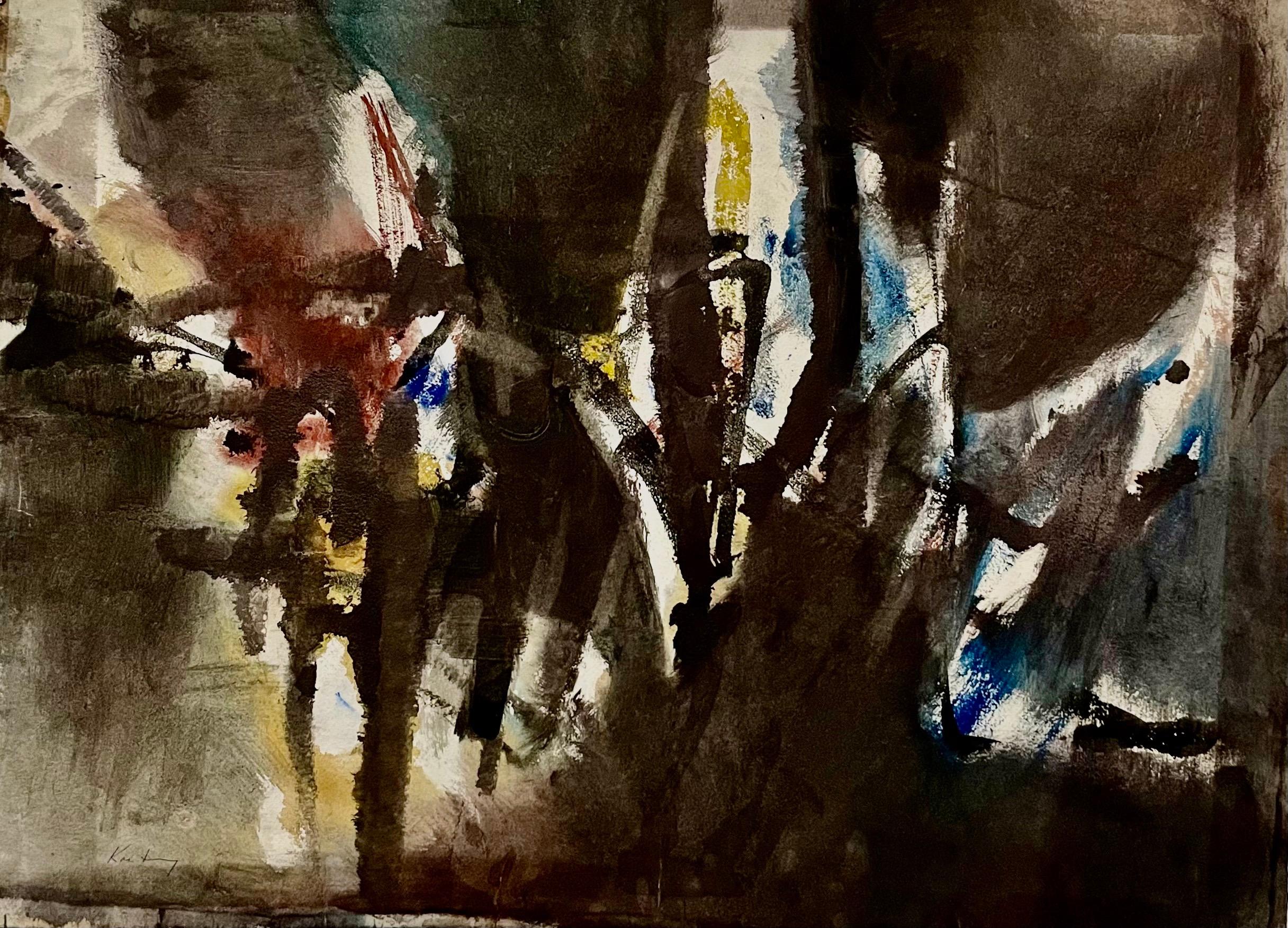Items Similar to The Rainstorm a watercolor by Allen Tucker
Want more images or videos?
Request additional images or videos from the seller
1 of 10
Allen TuckerThe Rainstorm a watercolor by Allen Tucker1930
1930
About the Item
Signed and dated "Allen Tucker 1930" lower left. Artwork measures 14" x 11 ¾" and framed 19" x 16 ½" x 2 ¼".
Provenance: Gift from the artist to his friend Una Brage, USA/Switzerland, in the 1930s
Estate of Ms. Brage to her friend Jean Corbett Peck, daughter of architect Harvey Wiley Corbett
By descent
About this artist: Allen Tucker, was an architect and painter so influenced by Vincent Van Gogh that he was called "Vincent in America". (Gerdts 291) Robert Henri and Maurice Prendergast were also credited as having an influence on Tucker's brushwork and compositions, the latter decisively. However, as his painting evolved, he did not fit into any tidy slot for description and was known as an individualist not easily categorized in American art history.
Tucker was born in Brooklyn in 1866 and graduated from the School of Mines of Columbia University with a degree in architecture and took a job as an architectural draftsman in the architectural firm of McIvaine and Tucker, his fathers business. During that time, he studied painting at the Art Students League with Impressionist John H. Twachtman, but it was not until around 1904, when he was 38, that Tucker became a full-time painter, leaving architecture behind. Many of his early canvases were classically Impressionistic with poplar trees resembling those of Van Gogh and haystacks and corn shocks emulating those of Claude Monet. However, he did not hold to his Impressionist style and explored other kinds of abstraction as well as architectural forms.
He became, in 1911, a charter member of the Association of American Painters and Sculptors, the group that would conceive, organize, select the artists and hang the 1913 Armory Show that shocked many persons by introducing abstract art to America. Tucker helped organize the landmark Armory Show of 1913 and in 1919 was also part of the founding the Society of Independent Artists, a group that rebelled against traditionalism.
In 1918, Tucker had his first large one-man show at the Whitney Studio Club (later the Whitney Museum of American Art) and became an advisor to Mrs. Juliana Force, who directed the Whitney Studio and the Whitney Studio Club. He was an Honorary Member of the Art Students' League, and taught at the League from 1921 to 1928. Tucker also wrote, "Here and There," a book of verse, 1919; "Design and Idea," 1930 and "John Henry Twachtman," 1931. His summers were spent painting in New Mexico, on the New England coast, in the Colorado and Canadian Rockies and in Europe.
Allen Tucker died in New York City in 1939.
His work is in the collections of the Albright-Knox Art Gallery, Buffalo, New York; Art Institute of Chicago; Brooklyn Museum; Metropolitan Museum of Art, New York City; and the Phillips Collection, Washington, D.C.
From David Michael Zellman, "Three Hundred Years of American Art"
- Creator:Allen Tucker (1866-1939, American)
- Creation Year:1930
- Dimensions:Height: 14 in (35.56 cm)Width: 11.75 in (29.85 cm)
- Medium:
- Movement & Style:
- Period:
- Condition:
- Gallery Location:Hudson, NY
- Reference Number:
About the Seller
5.0
Vetted Seller
These experienced sellers undergo a comprehensive evaluation by our team of in-house experts.
Established in 1973
1stDibs seller since 2023
6 sales on 1stDibs
Typical response time: 1 hour
- ShippingRetrieving quote...Ships From: Hudson, NY
- Return PolicyThis item cannot be returned.
More From This SellerView All
- Leaping Marlin (with fisherman on the boat Islander) by John WhorfBy John WhorfLocated in Hudson, NYJohn Whorf captures one of the thrilling moments of fishing in this watercolor – when the fish is on the line, but still trying to escape. One of the fastest fish in the world, marlin fishing...Category
1950s American Modern Animal Drawings and Watercolors
MaterialsWatercolor, Paper
- Mother and Children watercolor painting by John E. CostiganBy John CostiganLocated in Hudson, NYPainting measures 22" x 28" and framed 26" x 32" x 2" Hand-signed "J.E. Costigan NA 1952" lower left. About this artist: John Costigan was a self-taught painter distinguished by h...Category
Mid-20th Century American Impressionist Figurative Drawings and Watercolors
MaterialsPaper, Watercolor
- Delaware & Hudson Canal, Ellenville NY watercolor by Edward Lamson HenryBy Edward Lamson HenryLocated in Hudson, NYOriginal watercolor by Edward Lamson Henry looking back at barge travel through small New York state towns. Delaware & Hudson Canal, Ellenville N...Category
Early 1900s American Realist Landscape Drawings and Watercolors
MaterialsPaper, Watercolor
- Poplars, a watercolor by Allen TuckerBy Allen TuckerLocated in Hudson, NYThis 1930 watercolor by American artist and architect Allen Tucker is framed with museum quality, non-reflective glass and archival matting. It was gifted by the artist to his friend...Category
1930s American Impressionist Landscape Drawings and Watercolors
MaterialsPaper, Watercolor
- Touch of Fall watercolor and pastel painting by Nell BlaineBy Nell BlaineLocated in Hudson, NYSigned "Nell Blaine" upper left in pencil. Signed, titled, dated verso on sheet. Signed, titled, dated verso on backing panel. The artist. Exhibited at Fischbach Gallery, NYC, in 1994 (Gallery label verso, and wall label affixed verso). Purchased by private collectors c.1994. By descent. Tibor de Nagy Gallery, NYC (the artist's estate representative), exhibited 2020 (label verso). Exhibited at Fischbach Gallery, NYC, in 1994 (Gallery label verso, and wall label affixed verso). Tibor de Nagy Gallery, NYC (the artist's estate representative), exhibited 2020 (label verso). From her November 15, 1996 NYT obituary: Nell Blaine, a widely respected New York landscape painter and watercolorist, died yesterday at Mount Sinai Hospital. She was 74 and had homes in Manhattan and Gloucester, Mass. Ms. Blaine, who had been hospitalized since July, had been confined to a wheelchair since 1959, when she contracted polio. Ms. Blaine was born in Richmond, Va., in 1922, and first studied at the Richmond School of Art, now part of Virginia Commonwealth University. She moved to New York in 1942 to study painting with Hans Hofmann and later studied etching and engraving at Atelier 17 with Stanley William Hayter. During her first years in New York, her work, which had previously been tightly realist, turned abstract, inspired by Mondrian, Leger and Jean Helion. At one time she was the youngest member of the American Abstract Artists. She was also a founding member of the Jane Street Gallery, one of Manhattan's earliest artists' cooperatives, and had her first solo show there in 1945. Just as Ms. Blaine was becoming known as a promising abstract painter, and gaining the admiration of such critics as Clement Greenberg, she started to shift back to representation. Inspired in part by a trip with Larry Rivers in 1950 to Paris, where she was especially impressed by the work of Vuillard and Bonnard, she immersed herself in the tradition of 19th-century European painting. From the mid-1950's, she cultivated an increasingly painterly and colorful style, usually working directly from nature, or still life, with particular emphasis on the forms and hues of flowers. Her work retained a sense of all-over structure and pulsating energy that she nonetheless credited to abstract art. ''It all goes back to Mondrian,'' she would say. In the 1950's, Ms. Blaine was prominent among a circle of New York artists and poets that included John Ashbery, Frank O'Hara, Kenneth Koch, Mr. Rivers, Jane Freilicher, Leland Bell, Louisa Matthiasdottir, Robert De Niro Sr. and Rudy Burckhardt. She had her first solo show of representational work at the Tibor de Nagy Gallery in 1953 and was represented by the Poindexter Gallery until it closed in 1978, and, in recent years, by the Fischbach Gallery. During the 1950's she supported herself as a commercial artist, designing brochures for art galleries. In 1955, she designed the original logo, column heads and layout for The Village Voice. In 1957, Ms. Blaine was featured in Life magazine as one of five leading young female artists in America. In 1959, after several months of traveling and painting in Greece, she contracted severe bulbar polio on the island of Mykonos. ''To Nell Blaine,'' an exhibition organized at Poindexter to raise money for her hospital bills, included the work of 79 artists, including Saul Steinberg, Robert Motherwell, Elaine and Willem de Kooning, Philip Guston, Mr. Rivers, Ms. Freilicher and Robert Rauschenberg. After eight months in a New York hospital, including five months in an iron lung...Category
1990s Abstract Impressionist Landscape Drawings and Watercolors
MaterialsPaper, Watercolor, Pastel
- Hyacinth watercolor by Jessie Bone CharmanLocated in Hudson, NYAmerican artist Jessie Bone Charman (1895-1986) was known for her expressive still-life paintings, landscapes and marine scenes, as well as her abstract watercolors. The framed dim...Category
1930s Modern Still-life Drawings and Watercolors
MaterialsPaper, Pencil, Watercolor
You May Also Like
- "Manhattan Bridge" NYC American Scene Modernism Watercolor WPA Urban RealismBy Reginald MarshLocated in New York, NYReginald Marsh "Manhattan Bridge" NYC American Scene Modernism Watercolor WPA Urban Realism, 20 x 14 inches. Watercolor and pencil on paper, 1938. Signed...Category
1930s American Modern Landscape Drawings and Watercolors
MaterialsPaper, Watercolor, Pencil
- Untitled (Trees)By Charles E. BurchfieldLocated in Buffalo, NYAn original watercolor on paper by American modernist Charles E. Burchfield, created in 1916. This work comes in an archival frame presentation and has been authenticated by the Bur...Category
1910s American Modern Landscape Drawings and Watercolors
MaterialsWatercolor, Paper
- "Winter Wonderland (Snowman, Pine Tree, Rabbit), " signed by Sylvia SpicuzzaBy Sylvia SpicuzzaLocated in Milwaukee, WI"Winter Wonderland (Snowman, Pine Tree, Rabbit)" is a gouache and collage on paper bag signed by Sylvia Spicuzza. A winter scene showing a happy snowman that was created with arms up in the air and a top hat upon his head. In the foreground sits a bunny looking at the snow man...Category
1950s American Modern Landscape Drawings and Watercolors
MaterialsGouache, Paper
- Djibouti, African Landscape Original Israeli Watercolor Cityscape PaintingLocated in Surfside, FLSubject: Cityscape, signed in Hebrew Medium: Watercolor Surface: Paper Shmuel Katz (Hebrew: שמואל כ"ץ) (August 18, 1926 – March 26, 2010) was an Israeli artist, illustrator, and car...Category
20th Century Modern Landscape Drawings and Watercolors
MaterialsPaper, Watercolor
- Modernist Abstract Expressionist Watercolor Painting Bauhaus Weimar Pawel KontnyBy Pawel KontnyLocated in Surfside, FLAbstract watercolor composition bearing the influence of the earlier color-block compositions of Paul Klee. Pawel August Kontny, (Polish-German-American artist) He was born in Laurahuette, Poland, in 1923, the son of a wealthy pastry shop owner. In 1939 he began studying architecture in Breslau where he was introduced to the European masters and to the work of some of the German Expressionists, soon afterward banned as "degenerate artists" and removed from museums throughout Germany by the Nazi regime. His studies were interrupted by World War II. Drafted into the German army, traveling in many countries as a soldier, he sketched various landscapes but in 1945, he was captured and held as a prisoner of war in Italy. After the war, he studied at the Union of Nuremberg Architects to help design buildings to replace ones destroyed in the war. He recorded his impressions of the local population and the landscapes through his watercolors and drawings. Pawel Kontny thereafter moved to Nuremberg, Germany, becoming a member of the Union of Nuremberg Architects and helping to rebuild the city's historic center. He soon decided to concentrate on his professional art career. He married Irmgard Laurer, a dancer with the Nuremberg Opera. Pavel Kontny 's career as an artist was launched with his participation in an all German exhibition, held at the Dusseldorf Museum in 1952. He held one-man shows in Germany, Switzerland and the United States. During his trip to the United States in 1960, Kontny became instantly enamored with Colorado, and decided to relocate to Cherry Hills with his wife and two children. He quickly established himself in the local art community, being affiliated for a time with Denver Art Galleries and Saks Galleries. His subject matter became the Southwest. During this time he received the Prestigious Gold Medal of the Art Academy of Rome. His extensive travel provided material for the paintings he did using his hallmark marble dust technique. he also worked equally in pastel, watercolor, charcoal and pencil-and-ink. in a style which merged abstraction and realist styles, influenced by Abstract Expressionist painting and South Western American landscapes. This one bears the influence of Sam Francis. In the early 1960s he was one of only a few European-born professional artists in the state, a select group that included Herbert Bayer (1900-1985), a member of the prewar Bauhaus in Weimar and Dessau, Germany, and Roland Detre (1903-2001), a Hungarian modernist painter. As a Denver, Colorado resident, Pavel Kontny exhibited at galleries and museums throughout the United States, Germany and Japan. There, he was inspired by frequent trips to Native American pueblos in the Southwest, as well as by the study of the Plains Indians of Montana and Wyoming. Over the years Kontny had a number of students and generously helped young artist by hosting exhibitions at his Cherry Hills home. For many years he generously donated his paintings to support charitable causes in Denver. Influences during his European years included German pastelist C.O. Muller, German Informel painter Karl Dahmen and Swiss artist, Hans Erni. In the early 1950s his painting style showed the influence of the Die Brücke (The Bridge), a group of German expressionist artists formed in Dresden in 1905 who had a major impact on the evolution of modern art in the twentieth century in Germany. By the middle of the decade his style incorporated more referential abstraction and total abstraction, resulting in part from his study of Hans Hartung, a German artist based in Paris who exhibited his gestural abstract work in Germany. The American moon landing in 1969 inspired Paul Kontny...Category
20th Century American Modern Abstract Drawings and Watercolors
MaterialsWatercolor, Archival Paper
- Modernist Abstract Expressionist Watercolor Painting Bauhaus Weimar Pawel KontnyBy Pawel KontnyLocated in Surfside, FLAbstract watercolor composition bearing the influence of the earlier color-block compositions of Paul Klee. Pawel August Kontny, (Polish-German-American artist) He was born in Laurahuette, Poland, in 1923, the son of a wealthy pastry shop owner. In 1939 he began studying architecture in Breslau where he was introduced to the European masters and to the work of some of the German Expressionists, soon afterward banned as "degenerate artists" and removed from museums throughout Germany by the Nazi regime. His studies were interrupted by World War II. Drafted into the German army, traveling in many countries as a soldier, he sketched various landscapes but in 1945, he was captured and held as a prisoner of war in Italy. After the war, he studied at the Union of Nuremberg Architects to help design buildings to replace ones destroyed in the war. He recorded his impressions of the local population and the landscapes through his watercolors and drawings. Pawel Kontny thereafter moved to Nuremberg, Germany, becoming a member of the Union of Nuremberg Architects and helping to rebuild the city's historic center. He soon decided to concentrate on his professional art career. He married Irmgard Laurer, a dancer with the Nuremberg Opera. Pavel Kontny 's career as an artist was launched with his participation in an all German exhibition, held at the Dusseldorf Museum in 1952. He held one-man shows in Germany, Switzerland and the United States. During his trip to the United States in 1960, Kontny became instantly enamored with Colorado, and decided to relocate to Cherry Hills with his wife and two children. He quickly established himself in the local art community, being affiliated for a time with Denver Art Galleries and Saks Galleries. His subject matter became the Southwest. During this time he received the Prestigious Gold Medal of the Art Academy of Rome. His extensive travel provided material for the paintings he did using his hallmark marble dust technique. he also worked equally in pastel, watercolor, charcoal and pencil-and-ink. in a style which merged abstraction and realist styles, influenced by Abstract Expressionist painting and South Western American landscapes. This one bears the influence of Sam Francis. In the early 1960s he was one of only a few European-born professional artists in the state, a select group that included Herbert Bayer (1900-1985), a member of the prewar Bauhaus in Weimar and Dessau, Germany, and Roland Detre (1903-2001), a Hungarian modernist painter. As a Denver, Colorado resident, Pavel Kontny exhibited at galleries and museums throughout the United States, Germany and Japan. There, he was inspired by frequent trips to Native American pueblos in the Southwest, as well as by the study of the Plains Indians of Montana and Wyoming. Over the years Kontny had a number of students and generously helped young artist by hosting exhibitions at his Cherry Hills home. For many years he generously donated his paintings to support charitable causes in Denver. Influences during his European years included German pastelist C.O. Muller, German Informel painter Karl Dahmen and Swiss artist, Hans Erni. In the early 1950s his painting style showed the influence of the Die Brücke (The Bridge), a group of German expressionist artists formed in Dresden in 1905 who had a major impact on the evolution of modern art in the twentieth century in Germany. By the middle of the decade his style incorporated more referential abstraction and total abstraction, resulting in part from his study of Hans Hartung, a German artist based in Paris who exhibited his gestural abstract work in Germany. The American moon landing in 1969 inspired Paul Kontny...Category
20th Century American Modern Abstract Drawings and Watercolors
MaterialsWatercolor, Archival Paper
Recently Viewed
View AllMore Ways To Browse
Drawings By Architects
Large Landscape Watercolor
Large Landscape Watercolour
A Allen
New England Watercolor
The Phillips Collection
Classical Architectural Drawings
Vintage Drawing Ideas
An Allen
The Vintage Club Book
Framed Van Gogh
David Whitney
Allen Designs
Mexico 1930
Monet Drawings
New England Coast
John Allen
Van Gogh Drawings
